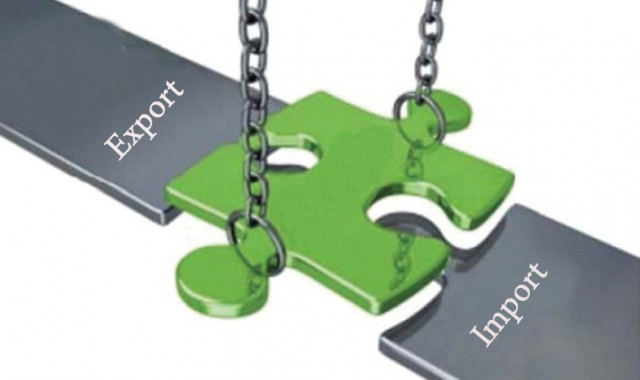Balance of trade: Oil price fall helps imports; exports remain disappointing
Trade figures reveal Pakistan’s dismal show continues; textile sector hit.

The textile group exports stood at $10.2 billion in July-March period, down by $163 million or 1.57% over the comparative period of the last fiscal year. . STOCK IMAGE
As trade figures for 2014 roll in, analyst have highlighted the dismal performance of key sectors that have led to the overall plunge of the balance of trade.
A few areas, mainly the power industries, were the country’s saving grace as Pakistan’s energy import bill shrank by over $2 billion during the first nine months of the current fiscal year. This saved precious foreign exchange reserves particularly at a time when the country is struggling to enhance its exports.
Additionally, the petroleum group imports amounted to $8.9 billion from July through March this fiscal year, which were $2.05 billion less than the comparative period’s imports, announced the Pakistan Bureau of Statistics on Tuesday.
By the end of January, global oil prices plunged by 60%, falling from June 2014’s level of $105 a barrel to $50 per barrel. The recent fall in crude oil prices is expected to reduce the net import bill of Pakistan by $2.8 billion in fiscal year 2014-15, according to International Monetary Fund’s (IMF) assessment.
The imports of petroleum products stood at $5.7 billion as against $6.63 billion in the previous year, showing a reduction of 14.3%. Similarly, petroleum crude imports also declined one-fourth to $3.2 billion.
High importing sectors
The gains helped the government fully offset the negative impact of overall exports that plunged almost 6% or $1.1 billion in the same period.

Although, the gains on reduction in oil import bill would ease the pressure on the foreign exchange reserves, which are gradually increasing due to heavy government borrowings, it would not provide any major relief to the policymakers. The IMF has already increased the target of gross foreign currency reserves by another $1.5 billion to $15.4 billion for the current fiscal year. Additionally, the IMF had also cautioned that increased volatility in oil prices could also destabilise investment or efforts to reform energy subsidies, advising Pakistan to remain focused on energy reforms.
Pakistan’s exports have not yet recovered and there were reductions across groups, showed the PBS data. The textile group that fetches six out of every ten dollars that the country earns by exporting goods, is still in negative trajectory.
The textile group exports stood at $10.2 billion in July-March period, down by $163 million or 1.57% over the comparative period of the last fiscal year. This is despite the fact that Pakistan is availing duty-free access to the markets of the European Union from January 2014. According to the assessment of Ministry of Commerce, Pakistani exporters are fast losing their competitive edge in the world market due to rupee’s overvaluation. The energy crisis was another factor that has barred the industries to run on their full capacity.
Within the textile group, the exports of cotton cloth amounted to $1.9 billion, $269 million or 12.6% less than the comparative period. The cotton yarn exports also plunged 7.5% to $1.5 billion. The bed wear exports also decreased 6.5% or $40 million to $1.6 billion.
The worrisome indicator was that there was dip in imports of textile related machinery, suggesting that the sector was not expanding. As against $426 million textile machinery import in July-March period of the previous fiscal year, the imports amounted to $336 million, showing over 21% decline in dollar terms.
Nevertheless, knitwear exports grew by 7.5% or $125 million to $1.8 billion. The readymade garments exports also increased 8.5% to $1.54 billion, from $1.42 billion.
During July-February period of this fiscal, Large Scale Manufacturing (LSM) grew only 2%, indicating that the overall growth in the current fiscal year would remain below the government’s target of 5.1%.
During July-March period, mobile phone imports inched up by 13% to $539.5 million.
The country also remained a net importer of the food group despite having vast agriculture land. Its imports of food group stood at $3.9 billion as against exports of $3.44 billion.
Published in The Express Tribune, April 22nd, 2015.
Like Business on Facebook, follow @TribuneBiz on Twitter to stay informed and join in the conversation.



















COMMENTS
Comments are moderated and generally will be posted if they are on-topic and not abusive.
For more information, please see our Comments FAQ